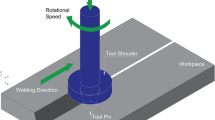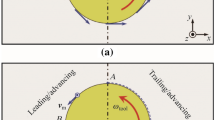Abstract
During friction stir welding or processing (FSP), temperature and deformation have influence on the final microstructure and mechanical properties. Studying microstructures before and after welding might help interpreting mechanical and corrosion resistance; however, microstructural evolution during the process remains unknown. In this study, a FSP model of pipeline steel plates was developed. Thermocouples were inserted in different positions and temperature cycles were collected during FSP. The collected data was used to complete the numerical model based on computational fluid dynamics (CFD). The CFD model simulated the material flow and heat transfer in FSP considering the material as a fluid. The standard error between the peak temperatures of the simulation and experimental results was below 1%. The model allowed correlating peak temperatures and cooling rates to the obtained microstructures after FSP. Numerical results showed that peak temperatures and dwell times in the stir zone were high enough to cause grain coarsening. This observation was demonstrated upon prior-austenite grain size measurements.
Similar content being viewed by others
References
Avila JA, Rodriguez J, Mei PR, Ramirez AJ (2016) Microstructure and fracture toughness of multipass friction stir welded joints of API-5L-X80 steel plates. Mater Sci Eng A 673:257–265. https://doi.org/10.1016/j.msea.2016.07.045
Avila JAD, Lucon E, Sowards JW et al (2016) Assessment of ductile-to-brittle transition behavior of localized microstructural regions in a friction-stir welded X80 pipeline steel with miniaturized Charpy V-notch testing. Metall Mater Trans A 47:2855–2865. https://doi.org/10.1007/s11661-016-3473-z
Hoyos JJ, Pereira VF, Giorjao RR et al (2016) Effect of friction stir welding on hydrogen content of ISO 3183 X80M steel. J Manuf Process 22:82–89. https://doi.org/10.1016/j.jmapro.2016.01.012
Fairchild DP, Kumar A, Ford SJ, et al (2009) Research concerning the friction stir welding of linepipe steels. In: Trends in welding research, 8th International Conference. pp 371–380
McPherson N, Galloway M, Cater SR, Hambling SJ (2013) Friction stir welding of thin DH36 steel plate. Sci Technol Weld Join 18:441–450. https://doi.org/10.1179/1362171813Y.0000000122
Colegrove PA, Shercliff HR (2005) 3-Dimensional CFD modelling of flow round a threaded friction stir welding tool profile. J Mater Process Technol 169:320–327. https://doi.org/10.1016/j.jmatprotec.2005.03.015
Nandan R (2008) Computational modeling of heat transfer and visco-plastic flow in friction stir welding. The Pennsylvania State University
Simar A, Lecomte-Beckers J, Pardoen T, de Meester B (2006) Effect of boundary conditions and heat source distribution on temperature distribution in friction stir welding. Sci Technol Weld Join 11:170–177. https://doi.org/10.1179/174329306X84409
Schmidt H, Hattel J, Wert J (2004) An analytical model for the heat generation in friction stir welding. Model Simul Mater Sci Eng 12:143–157. https://doi.org/10.1088/0965-0393/12/1/013
Lienert TJ, Stellwag WL, Grimmett BB, Warke RW (2003) Friction stir welding studies on mild steel. Weld J 82(1):1–9
Barnes SJ, Steuwer A, Mahawish S et al (2008) Residual strains and microstructure development in single and sequential double sided friction stir welds in RQT-701 steel. Mater Sci Eng A 492:35–44. https://doi.org/10.1016/j.msea.2008.02.049
Sinfield MF (2007) Advancements in physical simulation and thermal history acquisition techniques for ferrous alloy friction stir welding. The Ohio State University
Norton SJ (2006) Ferrous friction stir weld physical simulation. The Ohio State University
Allred J (2013) An investigation into the mechanisms of formation of the hard zone in FSW X65. Brigham Young University
Nelson TW, Rose S (2016) Controlling hard zone formation in friction stir processed HSLA steel. J Mater Process Technol 231:66–74. https://doi.org/10.1016/j.jmatprotec.2015.12.013
Ozekcin A, Jin HW, Koo JY et al (2004) A microstructural study of friction stir welded joints of carbon steels. Int J Offshore Polar Eng 14:284–288
Banerjee K, Militzer M, Perez M, Wang X (2010) Nonisothermal austenite grain growth kinetics in a microalloyed x80 linepipe steel. Metall Mater Trans A 41:3161–3172. https://doi.org/10.1007/s11661-010-0376-2
McQueen HJ, Yue S, Ryan ND, Fry E (1995) Hot working characteristics of steels in austenitic state. J Mater Process Technol 53:293–310. https://doi.org/10.1016/0924-0136(95)01987-P
Kumar A, Fairchild DP, Anderson TD, et al (2010) Research progress on friction stir welding of pipeline steels. In: International Pipeline Conference. pp 1–9
Almoussawi M, Smith AJ, Young A et al (2017) Modelling of friction stir welding of DH36 steel. Int J Adv Manuf Technol 92:341–360. https://doi.org/10.1007/s00170-017-0147-y
Kyffin WJ (2007) FSW as a repair technique for surface cracks in stainless steel. Cambridge
Cayron C (2007) ARPGE: a computer program to automatically reconstruct the parent grains from electron backscatter diffraction data. J Appl Crystallogr 40:1183–1188. https://doi.org/10.1107/S0021889807048777
Reiter J, Bernhard C, Presslinger H (2008) Austenite grain size in the continuous casting process: metallographic methods and evaluation. Mater Charact 59:737–746. https://doi.org/10.1016/j.matchar.2007.06.003
Nandan R, Debroy T, Bhadeshia HKDH (2008) Recent advances in friction stir welding – process, weldment structure and properties. 53:980–1023
Schmidt HB, Hattel JH (2008) Thermal modelling of friction stir welding. Scr Mater 58:332–337. https://doi.org/10.1016/j.scriptamat.2007.10.008
Qiao GY, Xiao FR, Zhang XB et al (2009) Effects of contents of Nb and C on hot deformation behaviors of high Nb X80 pipeline steels. Trans Nonferrous Metals Soc China 19:1395–1399. https://doi.org/10.1016/S1003-6326(09)60039-X
Antonino T de S, Guimarães PB, Alécio R de A et al (2014) Measurements of the thermophysical properties of the API 5L X80. Mater Sci Appl 05:617–627. https://doi.org/10.4236/msa.2014.58064
Gadakh VS, Adepu K (2013) Heat generation model for taper cylindrical pin profile in FSW. Mater Sci Appl 2:370–375. https://doi.org/10.1016/j.jmrt.2013.10.003
De A, Bhadeshia HKDH, DebRoy T (2014) Friction stir welding of mild steel: tool durability and steel microstructure. Mater Sci Technol 30:1050–1056. https://doi.org/10.1179/1743284714Y.0000000534
Fratini L, Buffa G, Palmeri D et al (2006) Material flow in FSW of AA7075–T6 butt joints: numerical simulations and experimental verifications. Sci Technol Weld Join 11:412–421. https://doi.org/10.1179/174329306X113271
Lee SJ, Lee YK (2008) Prediction of austenite grain growth during austenitization of low alloy steels. Mater Des 29:1840–1844. https://doi.org/10.1016/j.matdes.2008.03.009
Zhang SS, Li MQ, Liu YG et al (2011) The growth behavior of austenite grain in the heating process of 300M steel. Mater Sci Eng A 528:4967–4972. https://doi.org/10.1016/j.msea.2011.02.089
Momeni A, Kazemi S, Ebrahimi G, Maldar A (2014) Dynamic recrystallization and precipitation in high manganese austenitic stainless steel during hot compression. Int J Miner Metall Mater 21:36–45. https://doi.org/10.1007/s12613-014-0862-4
Fairchild DP, Wasson AJ, Kumar A, et al (2012) Fractographic investigation of cleavage initiation in steel friction stir welds. In: Trends in welding research, 9th International Conference. pp 193–200
Li X, Shang C, Ma X et al (2017) Elemental distribution in the martensite–austenite constituent in intercritically reheated coarse-grained heat-affected zone of a high-strength pipeline steel. Scr Mater 139:67–70. https://doi.org/10.1016/j.scriptamat.2017.06.017
Acknowledgements
The authors would like to thank the LNNano for the provision of the FEI ® Quanta 650FEG SEM/EBSD microscope, FSW machine, and metallography facilities; PETROBRAS for providing economic funding; and Tenaris Confab for the material donation.
Author information
Authors and Affiliations
Corresponding author
Rights and permissions
About this article
Cite this article
Avila, J.A., Giorjao, R.A.R., Rodriguez, J. et al. Modeling of thermal cycles and microstructural analysis of pipeline steels processed by friction stir processing. Int J Adv Manuf Technol 98, 2611–2618 (2018). https://doi.org/10.1007/s00170-018-2408-9
Received:
Accepted:
Published:
Issue Date:
DOI: https://doi.org/10.1007/s00170-018-2408-9




